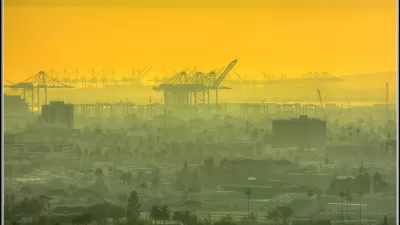Chinese and Indian cities are known for having some of the most polluted air in the world. You've likely heard about Beijing's severe smog; but in Delhi, where pollution levels are regularly higher, the hazardous air gets little notice. Why?
"Lately, a very bad air day in Beijing is about an average one in New Delhi," observes Gardiner Harris. But you wouldn't guess that's the case if you followed the international media or spoke with Delhiites. Even though "India has the world’s highest death rate because of chronic respiratory diseases, and it has more deaths from asthma than any other nation, according to the World Health Organization," you rarely hear mention of the air pollution problem by public officials or Delhi residents.
Why does Beijing's bad air get so much more attention? Some point to the Chinese government's efforts to keep environmental information from the public. “I think when you have the sense that they’re hiding something, it galvanizes public attention in a counterintuitive way,” said Ananth Krishnan, the China correspondent for The Hindu. “I don’t think the Indian media has given enough attention to this issue," he added. "I remember an Indian environmental scholar visited Beijing a few months ago, and he was surprised that pollution was getting so much attention in the press here."
"Coverage of air quality by the Indian news media 'will have to change very soon,' Mr. Krishnan said."
FULL STORY: Beijing’s Bad Air Would Be Step Up for Smoggy Delhi

Study: Maui’s Plan to Convert Vacation Rentals to Long-Term Housing Could Cause Nearly $1 Billion Economic Loss
The plan would reduce visitor accommodation by 25,% resulting in 1,900 jobs lost.

North Texas Transit Leaders Tout Benefits of TOD for Growing Region
At a summit focused on transit-oriented development, policymakers discussed how North Texas’ expanded light rail system can serve as a tool for economic growth.

Why Should We Subsidize Public Transportation?
Many public transit agencies face financial stress due to rising costs, declining fare revenue, and declining subsidies. Transit advocates must provide a strong business case for increasing public transit funding.

How to Make US Trains Faster
Changes to boarding platforms and a switch to electric trains could improve U.S. passenger rail service without the added cost of high-speed rail.

Columbia’s Revitalized ‘Loop’ Is a Hub for Local Entrepreneurs
A focus on small businesses is helping a commercial corridor in Columbia, Missouri thrive.

Invasive Insect Threatens Minnesota’s Ash Forests
The Emerald Ash Borer is a rapidly spreading invasive pest threatening Minnesota’s ash trees, and homeowners are encouraged to plant diverse replacement species, avoid moving ash firewood, and monitor for signs of infestation.
Urban Design for Planners 1: Software Tools
This six-course series explores essential urban design concepts using open source software and equips planners with the tools they need to participate fully in the urban design process.
Planning for Universal Design
Learn the tools for implementing Universal Design in planning regulations.
Ascent Environmental
Borough of Carlisle
Institute for Housing and Urban Development Studies (IHS)
City of Grandview
Harvard GSD Executive Education
Toledo-Lucas County Plan Commissions
Salt Lake City
NYU Wagner Graduate School of Public Service




























